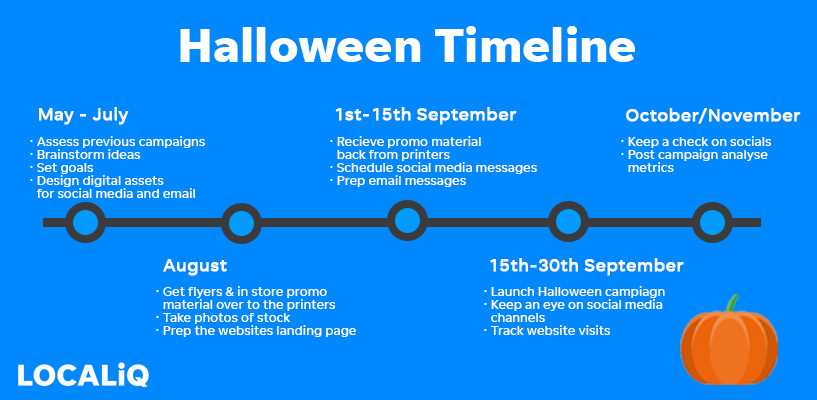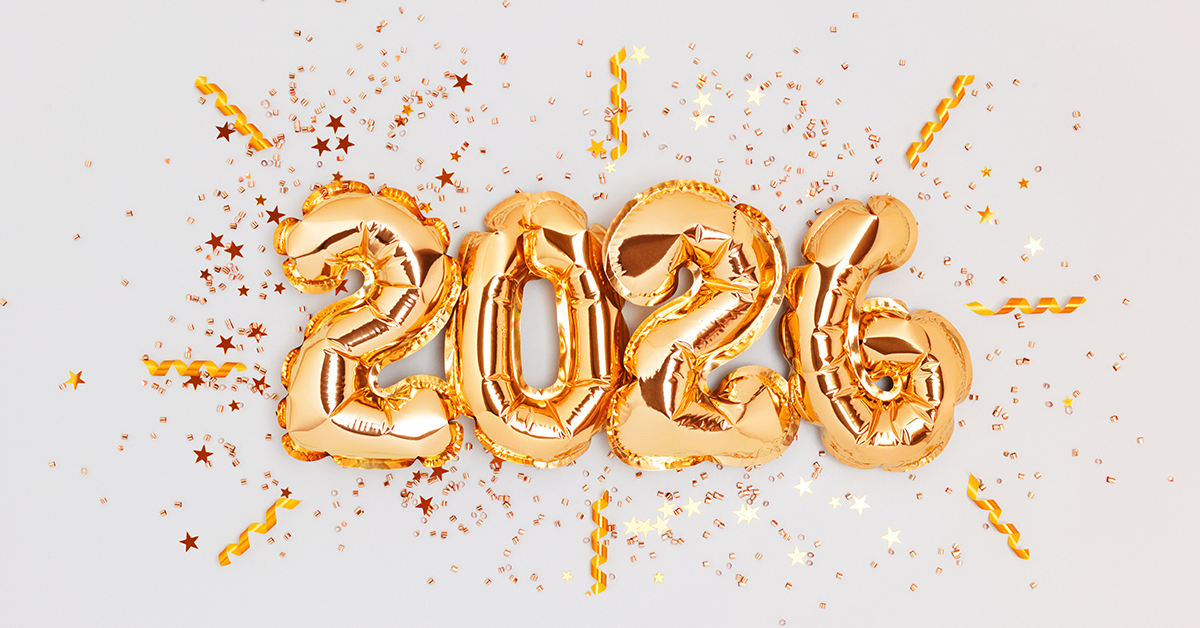Seasonal campaigns are a staple in any business’s marketing strategy, but it can be hard to plan for them. Prepping for the holiday season occurs long before any pumpkins or sleighs make an appearance. Seasonal campaigns can make or break a business, so it is worth setting aside some time to plan and prepare for these occasions.
This blog will provide suggestions for running a successful campaign with timeline guides for several key dates of the year including Halloween, Christmas, Black Friday, Cyber Monday, and New Year.
In this blog, we will discuss:
- Things to consider before you begin to plan your seasonal marketing campaign
- How to plan your campaign
- Planning and execution of seasonal marketing
- Key seasonal marketing dates for 2023
- Halloween marketing campaigns
- Christmas marketing campaigns
- Black Friday/Cyber Monday marketing campaigns
- Boxing Day/New Year’s sales marketing campaigns
Things to consider before you begin to plan your seasonal marketing campaign
We always say to start as early as possible with your campaign and seasonal marketing strategy. That way, by the time the big event comes along, you are ready to hit the ground running. Whether you’re planning a marketing campaign for the first time, or you’re a seasoned pro, you’ll need some planning and organisation skills to get you through. Let’s look at how you can plan that seasonal campaign.
- Consider your seasonal branding and messaging – You may want to have everything Christmas-themed, however, you still need to consider your core branding. Some businesses that sell their products and services via websites have a section dedicated to the season. Brand awareness is always important so even if you are making everything seasonal, make sure that your brand still stands out in its logo and offerings.
- Define your audience – The most important part of any marketing campaign is to define your audience. Who is going to buy your product? If you are not sure, you can look at your current customers – what are their age ranges, gender, and even what interests they have?If you have multiple social media channels, what are the demographics of your audience there? Do your demographics alter between platforms? Do they match the demographics of your customers?Once you have your audience perfected, it’s time to create a campaign that they resonate with. Consider your audience when planning. Will they want an omnichannel experience where the offering and communications are exactly the same regardless of whether they visit a physical store or access your brand through digital channels like social media and your website?Alternatively, do you want to tailor your campaign to individual online platforms/offline print advertising or in-store? The latter while being more targeted, can be more time-consuming and costly.
- Review previous campaigns – If you ran a campaign the previously, then hopefully you found time to evaluate it. If not, now is the time to evaluate how your audience viewed your campaign and if you saw increased profits, from that year to previous years. Was there anything that worked particularly well and indeed the opposite, what did not work well? By identifying your strengths and weaknesses from previous campaigns, you know what to replicate and what to drop.
- Identify KPIs and set yourself goals – Your KPIs (Key Performance Indicators) provide a way for businesses to gauge their progress and provide insights that allow for better business decisions. KPIs can be run at a whole business level right down to teams and even individuals. Some KPIs that you may want to focus on could include:
-
-
-
- Social Media – increased followers, more conversations online.
- SEO – organic traffic increases, more sales, lower abandoned baskets.
- Sales – Your goal needs to reflect your objective. What do you want to achieve? No doubt you have heard of SMART (specific, measurable, achievable, realistic and time-bound) goals. Using the example that you want to achieve more sales, your SMART goal could be “By Christmas Eve (time-bound), I want to achieve £5,000” (measurable element) in sales. It could even be “This December (time bound) I want to see a 10% profit (measurable) compared to last year.” Again, the goal is specific (it says directly what they want to achieve), and a 10% sales uplift is achievable and realistic. What this hasn’t defined yet is HOW they are going to achieve their goals.
-
-
How to plan your campaign
Before we look at the how let’s look at the WHY. Why should you plan your campaign? Well, planning allows you to allocate time, expertise, experience, and cost to the campaign. Planning allows you to take stock of what you already have against what you will need for your campaign.
Now you have done the leg work, it is time to focus on creating excellent marketing campaigns to help your business grow. Planning your campaign can take some time and effort. You want to ensure that your campaign resonates with people especially as they will be the ones making sales. We suggest that you prepare early and depending on the length of the campaign, you may need to give yourself 4-6 months for brainstorming, planning and indeed making any changes that reflect the environment.
The most important thing for you to consider is HOW will you ensure that your brand will stand out from all the other brands’ campaigns. Striking imagery and well-designed graphics are necessary.
If you are not comfortable with design, you could hire a professional graphic designer to work their magic on your landing page, social media posts etc, There are also free tools such as Canva which can help you design beautiful graphics. Canva offers both a free and paid option.
If you want to find some imagery for your campaign, you can get free high-quality images on pexels.com or unsplash.com. We do advise you to try to avoid using too many stock images, as a lot of brands will be using them and could be using the same or remarkably similar images that you are using. This will not help you stand out at all.
If you can take some images yourself then great as these will be much more original. These images can be of your new stock or special Christmas stock, all on a nice Christmassy background. Make sure that your products stand out here as they are the focal point. If you are running ads on Google, you can now use generative AI which can change the backgrounds of your product images. This will be a simple way to add some seasonality to your existing brand images.
-
- Create your themed landing page
A landing page on your website dedicated to the campaign is a must. This webpage needs to include some CTA’s (call-to-action). Do you want them to download a brochure? Shop now? Call you? Make sure your CTA is large enough and has some space around it, so the viewer’s eyes are drawn to it. In addition to this, ensure that your site has been optimised as people want speedy websites. You should also be creating UTMs, so you are aware of where your traffic is coming from. You can set up a different UTM for each social media channel, Google or Bing paid ad, and so forth. Additionally, if you are running A/B testing on different ads, then these need different UTMs too. Google Analytics has a tool to design your UTMs. - Get your social media up to scratch
Your social media needs to be managed effectively over the campaign period. Take the time to schedule your social media posts in advance to allow you to concentrate on other tasks during the busy period. Don’t forget to remain active on social media, and respond to customer requests, issues, complaints etc.Make sure you let people know if you are offering gift cards. These make great gifts and can help you generate some footfall in the quieter months. - Run a video campaign
Did you know that video is 27 times more likely to be clicked on than images? Social media prioritises video content over imagery. Reels are especially popular on both Facebook and Instagram.These days, video is inexpensive to produce. Gone are the days when customers expect brands to produce high-end videos, sometimes the best videos are those which are authentic. While creating your own videos can be fun, the creating and editing process can be time-consuming. Consider some UGC (user-generated content). It requires little effort on your part (apart from asking the makers’ permission to share it) and is seen as truly authentic by people on social media. - Add a sprinkle of influencer marketing
Do you know any influencers that may be interested in working with your business? These influencers do not need to have millions of followers, a small number is fine if their following matches your audience or target audience. - Encourage customer loyalty
You could reward all existing customers or email sign-ups with a discount or even an early bird discount code. This has worked particularly well for many larger brands (think Amazon and their Prime early deals). - A dedicated hashtag
Why not get a dedicated hashtag for your campaigns? That way if you get some UGC, they can also use your dedicated hashtag. Your hashtag needs to be memorable (so people know what to search for and what to tag with). You could go for something as simple as #YourShopHalloween or #YourBusinessChristmas.While a dedicated hashtag is good, don’t scrimp on your hashtag strategy. Make sure you are using hashtags relevant to your offering as well as seasonal ones.
- Create your themed landing page
Planning and execution for seasonal marketing
You should be planning for campaigns 4-6 months ahead to have everything ready to go a month before the campaign goes live.
You should also ensure that you have scheduled your social media posts (and ads). You can use a social media scheduling tool such as Hootsuite, Later or Sprout Social. Some of these also offer a free version but are limited to a small number of posts you can schedule.
Meta has either Business Suite or Creator Studio which allows you to schedule posts and once these posts have gone live, they also offer insightful metrics
You can sign up for our newsletter now for monthly updates on all things marketing including campaign planning.
The shopping period for each event varies too, from a couple of days to a couple of months. Obviously, you want to start promoting your goods just before the shopping period, so your business is in people’s minds already.
Key seasonal marketing dates for 2023
There are several key dates between October and January. We have highlighted them below for you to help you plan your marketing over the season.

Marketing campaigns for Halloween
You should begin planning for Halloween by May – July and follow all the tips in this blog to get yourself ready.
By the beginning of September, you should have all your campaign assets in place. Make sure that you have scheduled your posts to go out over the spooky season.
If you need anything printing such as store posters or flyers, then get them to the printers for mid-August; this allows the printers plenty of time for them to print them and return them to you. Around mid-September to 1st October is a suitable time to launch your campaign (in-store and online).
Marketing campaigns for Christmas
Christmas makes up almost 25% of all annual retail sales, and other industries such as hospitality also report huge increases in profits, it’s no wonder that Christmas is big business. To ensure that they get the most out of the Christmas season, businesses need to plan effectively. Get people in the Christmas spirit ready to help you boost sales.
According to YouGov, the average person in the UK spends £1,108 on Christmas with women spending slightly more than men. Of that £1,108, a third of that will be spent on gifts. When you consider that spend, there is enormous potential for businesses to appeal to and promote their offerings to their audience over the Christmas period.
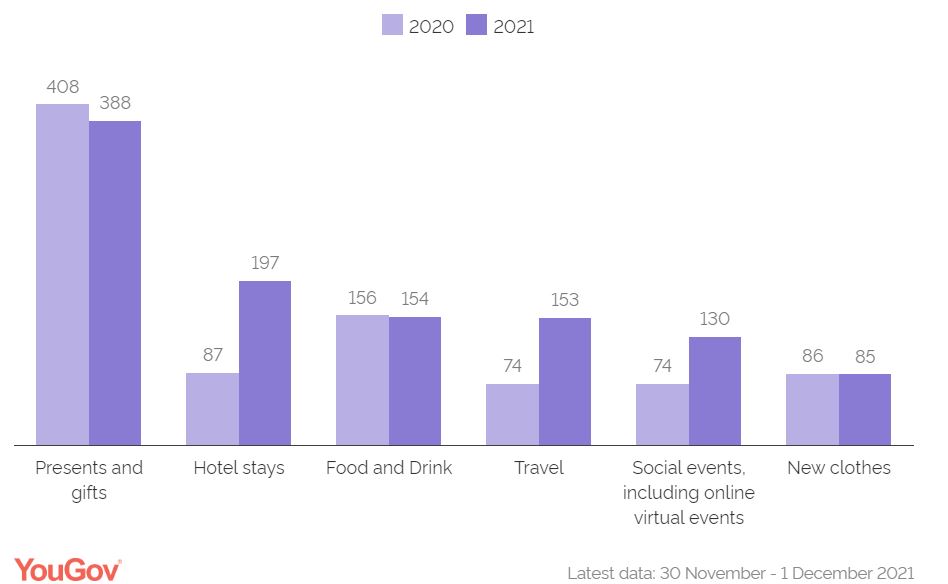
Image Source: YouGov 2020 v 2021 spend
We know Christmas is a time for family, friends, and traditions. Marketers and advertisers often try to capture these in their marketing. If you want to get people to resonate and feel the spirit of Christmas, then you need to appeal to their senses.
Here are our top 3 tips for a great Christmas campaign:
-
-
- Get nostalgic – remind people of great times gone by.
- Traditions – like nostalgia, have a campaign around great Christmas traditions.
- Emotive campaigns – really pull on those hearty strings and get emotional.
When to start your campaign.
-
When to start your campaign
You need to be giving yourself 4-6 months to design your Christmas marketing ideas. You want to start around July to maximise your planning time. If you are super-organised or have a dedicated team to help you, then September at the latest.
Allocate time, resources, and budget to your seasonal campaigns, as this will be the busiest time of year for you. This will help you prioritise and avoid over-stressing yourself. Just remember, you may already be busy in October with your Halloween campaigns so the earlier you can plan for Christmas the better.
The end of September is a suitable time to finalise imagery for your Christmas campaigns, and by the middle of October, you need to get everything sent off to the printers. This could include promotional material (flyers, in-store posters, etc.) and any uniform designs. Some stores have fabulous Christmas uniforms or t-shirts that are fun and can carry valuable information such as social follows or even offers that you are running, for example, “Ask me how I can save you money this Christmas.”
Pro Tip – If your business is in a shopping centre, enquire about their Christmas marketing plans. Some centres provide activities for kids (e.g., find a letter in every window and win a prize). Some may offer family events, visits from Santa and the Grinch or even have a prize draw.
If you are a solo from home business, why not participate in a couple of local craft fayres or markets to get your name out there (and don’t forget to get plenty of business cards and leaflets printed to hand out)? All these are great ways for you to promote your business locally for little cost.
We suggest that in early November, you begin to schedule your social media messages, and throughout the following 2 months, check your social media regularly to make sure you are answering any queries. You should also start ramping up your email campaign now.
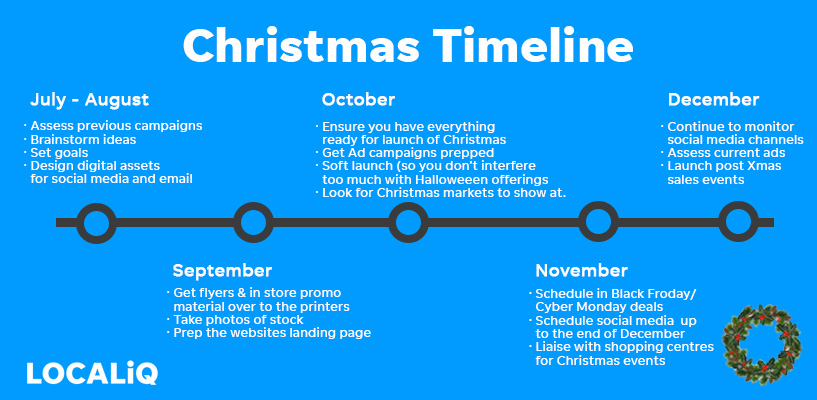
Marketing campaigns for Black Friday/Cyber Monday
While Black Friday and Cyber Monday are only for a day each, there has been a shift in recent years that sees Black Friday last the weekend or even the week. These events can be incorporated into your Christmas campaign, although you may want to run them as smaller separate campaigns.
You want to start teasing your offerings in early November, about a week before your plan to launch your Black Friday/Cyber Monday deals. You can offer a basic discount such as 10% off a particular range, or you could use this event to get rid of older stock with a special Black Friday/Cyber Monday deal.
Again, in the run-up to both Black Friday and Cyber Monday, you need to be communicating with your audience as well as making sure all stock that will be in the offer is ready to go. If you are selling a physical product, and you have a surplus, these can be added to your New Year sale.
Post-event, if you have a website, you will want to assess where your traffic came from. If you accept returns, you may want to wait until after your return period before measuring sales. You can measure year-on-year sales against the same period last year to see if you have made improvements.
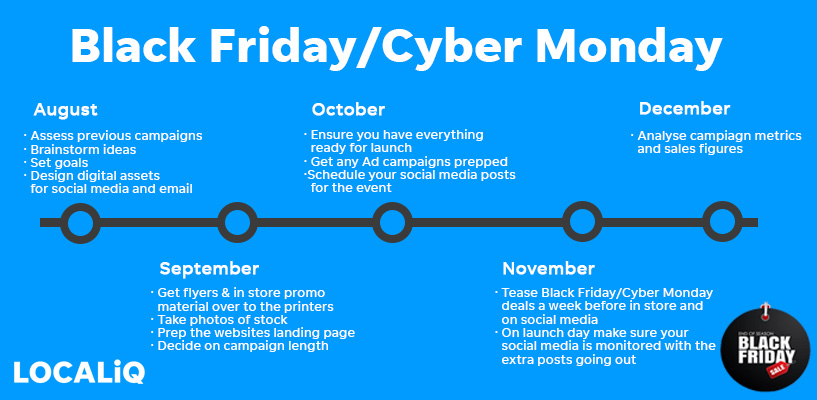
Marketing campaigns for Boxing Day/New Year’s sales
Boxing day and News Year’s sales are more examples of campaigns that can be incorporated into your marketing strategy or run as individual campaigns. One advantage to running them separately is that you give focus to each event and can plan out what metrics you want to measure. These may differ for each campaign.
We have eaten our own body weight in roast dinners and mince pies, it’s now time to begin to get rid of the stock or make some fresh offerings for a start to the new year. Some businesses start their sales on Boxing Day (we are looking at you Next, with your 5 am starts), while other stores opt for a new year’s sale.
Again, you can do the bulk of the work beforehand, with a landing page prepared on the website and generic sales posts (if you don’t know what stock you will have on offer). You may want to pre-schedule posts as early as possible as you may be too busy from Halloween to Christmas to have the time to pre-schedule tweets.
Once your sale is over, you need to give it a few weeks to allow for returns before you analyse sales over the period. You may want to look at other metrics too, such as social media growth, and how people found you.
And don’t forget before the new year even begins, Valentine’s day is already being marketed!
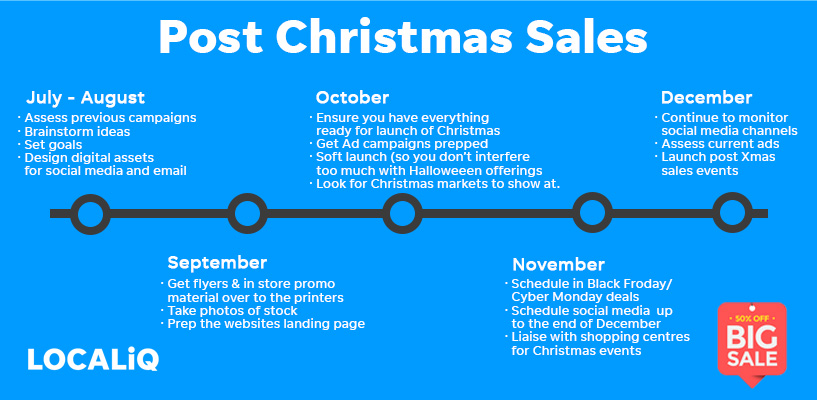
The last quarter of the year is a busy one for many businesses and we hope that this guide is useful for you for building your campaigns from Halloween to New Year’s sales. If you need an agency you can trust then contact us today to see if we can help you with any aspect of your campaign, from SEO to paid social media advertising or from video production to web design.

